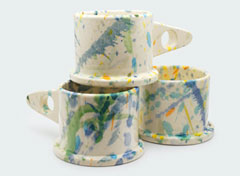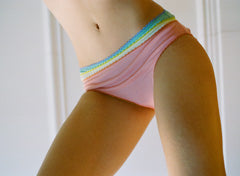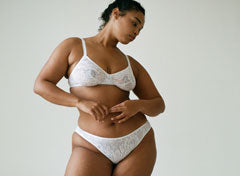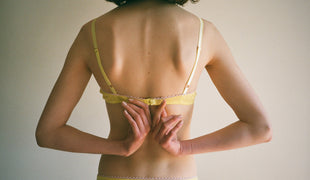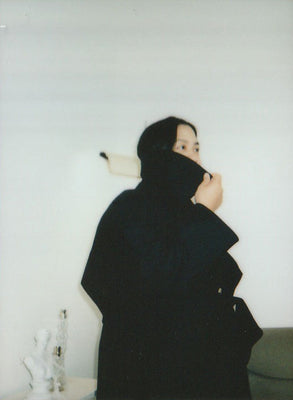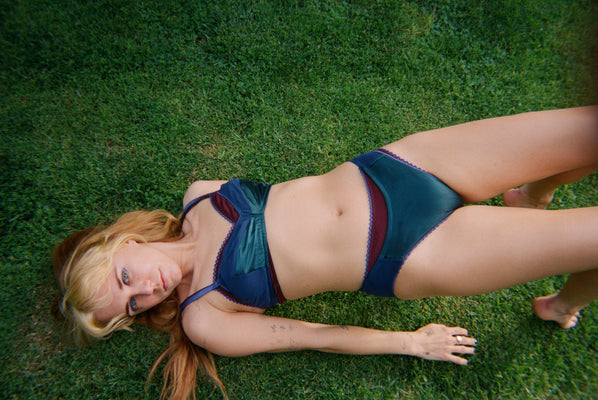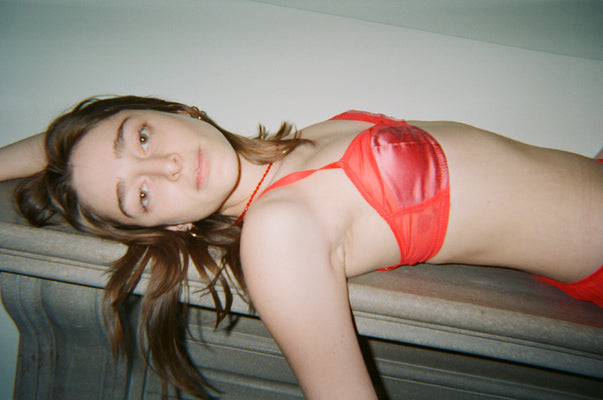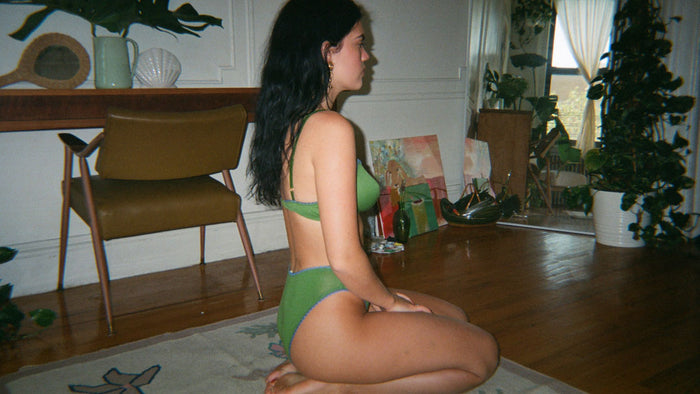JOURNAL
Araks and Creative Director Tony Yumul sit down to discuss with us friendship, collaboration, and the origins of this unique and well-regarded project.

Hi Araks and Tony, can you tell us how you met?
Tony Yumul: I remember us always being at the same places at the same time.
Araks Yeramyan: We were both friends with a bunch of Swedish people.
T: That’s also how I met my wife.
A: We were the only non-Swedes.
That was in 2003, so you knew each other for a while before doing Lingerie On Film?
T: Yes, we worked on a few things together before Lingerie On film. We did some invitations and a more typical lookbook for the Araks organics line. For the lingerie line we wanted to do something bigger, and so we started brainstorming together.
A: I wanted to do something natural, no hair and make up, no retouching, and I wanted to use someone who was not a photographer to shoot. I also wanted someone close to the brand. I suggested that we ask Sofia Coppola.
T: I didn’t think it would work. I thought it would be boring. But then, I had the idea to get a different person for each page and to use disposable cameras. I remember I was on the phone with you, Araks, at Crosby and Grand, and I stopped because I got so excited. We wanted to do something more than just a pretty girl in lingerie. There was also something about getting people involved in the creative process. Taste makers and people that would represent the brand in different ways. We wanted something bigger than just a look book and more importantly, I was like, who do we want at the party? Because you want to curate the crowd of people. You want to celebrate it with them.
A: It started with people who were intimately close to the brand. A few of them were from our mutual Swedish friend group - Adina Fohlin, Peter Elofsson, and Magnus Berger. And other friends - Robert Geller, HeatherMary Jackson, Mark Gonzales, and Cheryl Dunn. I knew everyone who participated in the first edition, except for Eva Fontanelli. I was so into her whole look and attitude. She was the first person that we reached out to just to see if she would be interested.
Did you expect her to say yes?
A: No, I just went for it. I was beyond excited when she wrote back and accepted.

Photos by Eva Fontanelli
It’s such a nice way to build a circle of people around a brand.
A: It's been a wonderful way to build a community of like minded people around Araks.
T: Rather than a pretty girl in a book, it becomes something that people are a part of. Due to it's inclusive nature, people are talking about it that wouldn’t typically be talking about it. Whether it’s people in fashion or outside, like Jason Schwartzman, the process gives life to the project.
A lot of people would say that this is a very risky way to create a brand’s lookbook. It’s the main visual asset that goes into the world to convey what the brand's about. You weren’t worried about handing over that amount of control to non-photographers?
A: No, I wasn’t worried, but I am very careful about what images we produce for the brand. Taking this risk and letting go a little has helped me grow as a person. I love creative collaborations and embracing other people's perspectives.
T: You give up some control, but that’s what’s cool about it.
A: It’s equal risk for everyone.
Do you get nervous when the cameras are out with the participants?
A: Of course.
T: We pick people who we feel have a sensibility that will work. My fear as a creative director is that the photos are going to come back, and it’s going to be hard to put stuff together. But, because the medium is the same, all of the images have the same old kind of grain and are not perfect. That color is hard to manufacture with digital - there’s a cohesion amongst everyone’s images because of the medium. It is the weird democratizer.
Did you think about the timeless quality that film would give this project?
T: I knew the images would connect from year to year, but i didn’t know that we would be doing the project for this long. You can’t really tell that there are seven years in between the first and last books, 2011 to 2017, they're ageless.
Do you think there’s something to this imperfectness that speaks to the brand?
T: Yes, it has an analogue warmth, a quirkiness. And this is technical, but everyone looks kind of great because it’s soft. You shoot with digital and you see everything. It’s like you’re a dermatologist.

Photo by Maryam Nassir Zadeh
Are there always surprises?
A: There are people that you might not automatically consider to be visually creative, but there is a reason we chose them. The film comes back and there are so many amazing photos that we don’t know which ones to publish.
T: It’s surprising for everyone. When Shirley get’s the film back and sends it to me, there is so much discovery.
Do you think the kind of pictures that people take has changed through the past seven years with the rise of Instagram and camera phones?
A: There are a lot more selfies. As the years go by, people have become more and more conscious of themselves as a brand.
T: Yes, people now are more in tune with photography. Everyone kind of knows how to compose a picture. But the camera format really equalizes everything. You get the same quality of image, whether the person knows how to take photos or not.
It’s really cool that people are willing to participate in a image based project that allows them very little control.
A: Yes, we took all control out. People can’t see what their images look like because it’s a disposable camera. They can’t tweak them. There’s no retouching. But, there are also no expectations which allows people to really be uninhibited. Everyone is equal.
T: It helps when we show people the past books. The first two books were really made with people we knew, and they trusted that we were going to put something beautiful together. Then it just built on itself. People aren’t worried that they are going to take some weird picture, and we’re going to publish it.
A: I think that when you get into a mutually vulnerable relationship creatively it makes the work stronger. There’s so much trust on both ends.
Photo by Alexa Chung
When you started this project were there other brands doing anything like this? Something so natural?
T: No, everyone wanted things to look perfect.
A: I think people are accepting and celebrating imperfection more and more now, so we are seeing natural beauty in fashion campaigns, especially lingerie. But when we started, definitely not.
What is the collaboration between the two of you like when the film comes back from the participants?
A: If I’m around when the film comes back, I always take a peek. Otherwise, the film goes straight to Tony and I’m not really involved. Then I try to get involved. But in the end Tony’s always right. I’m like, I think we should try something else, and then he tries, but then we usually go back to what he originally did.
T: That’s right.
A: Tony knows best.
T: Araks is the best collaborator.
A: Yes, because you get to do whatever you want.
T: Best kind of collaboration.
How did you decide on the layout of the book?
T: It’s simple, i love paper and a tactile sense. It’s all letter pressed and the paper is uncoated. It feels more natural and softer that way. Not binding the book makes it seem less commercial. You could easily take out the pages and add them to a mood board or pin them up without tearing the book apart. It allows for way more interaction than with a typical book. We wanted to pull it as far as possible away from being commercial. There’s not many words.
A lot of graphic designers like consistency, and what I love about this is the inconsistency. From spread to spread it’s a different photographer. We pace it, so hopefully it feels nice, but there’s a surprise on every page. I want people to be surprised, you know like “that’s funny or weird, or odd.” It’s nice to have this kind of freedom and to be able to do something not so commercial.
A: There’s no restraints for anyone.
T: Yes, there are no rules when we send the cameras out. I was worried that all the shots would be off figure because you know it’s hard to get people to be shot in lingerie. But it comes back and people do it and it’s pretty balanced.
Do you send any suggestions to the participants on taking their photos?
A: Use the flash indoors, take as many photos as possible, and the lingerie usually looks better on a body.
Do you have a favorite edition so far?
T: Mine is always the most recent.
A: Ya, me too.
Favorite Contributor?
A: Yes, William, a three year old boy - HeatherMary’s son. If you see the roll of film that he shot, it’s really well art directed. The whole thing. We could have created a book just on his photographs. One of his images was the front cover that year. Everything was off a little and not quite right, but it was beautiful.

Photos by William Jackson Gonzales
Dream Participant?
A: Sofia Coppola.
Have you had any big realizations while working on this project together?
T: It’s always surprising what people will do if you ask.
A: You have to have trust in other people . And if you go for it, you can’t loose.
T: I'm not a photographer, but when I was a participant I had so much fun. To be creative with so much freedom is amazing.
Where do you see this project going in the future?
T: We have talked about how we could take this into motion. We would love to do video.
Can you reveal anything about the upcoming book?
A: It’s all women, it’s a really great group, and that’s all I have to say about it..right now.
What’s your favorite thing about the project?
A: I like that it’s a true collaboration - 100%. There’s a mutual respect between us and the participants, and I think that’s rare. Most collaborations these days are paid.
T: This book is like analogue social media, creating all this stuff with people you like. It’s like a wonderful mix tape.
A: And it’s timeless, it just keeps going. It’s not dated. All of the books just work together, forever.




